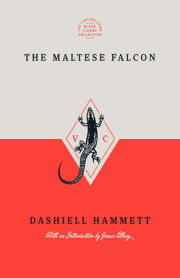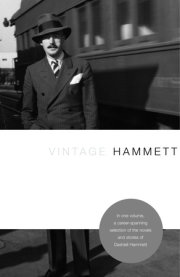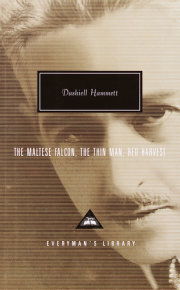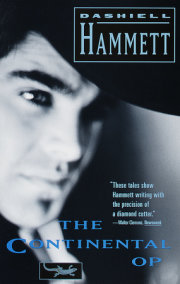Foreword
“THROUGH MUD AND BLOOD AND DEATH AND DECEIT”
Julie M. Rivett
This long-awaited volume you hold in your hands is the first and only collection to assemble every one of Dashiell Hammett’s pioneering Continental Op adventures—twentyeight stand-alone stories, two novels, and Hammett’s only known unfinished Continental Op tale. It is truly definitive. And it has been many decades in the making. At the time of this writing, the first Op story is ninety-four years old and the last is seventy-nine, not including “Three Dimes,” an undated draft fragment conserved in Hammett’s archives, first published in 2016. The gritty sleuth Hammett described as a “little man going forward day after day through mud and blood and death and deceit” has weathered gunshots, grifters, criminal conspiracies, class struggles, temptations, neglect, and more. This volume is testament to his tenacity. He is a survivor, a working-class hero, and a landmark literary creation.
The Continental Op stories are rooted in Hammett’s experiences as an operative for Pinkerton’s National Detective Agency. Although Hammett worked for Pinkerton’s for a scant five years—before and after his service in the U.S. Army during World War I—the job inspired both his writing career and his worldview. Some influences are plain. The Continental Detective Agency, for example, is modeled on Pinkerton’s, their Baltimore office located in the Continental Trust Company Building, where Hammett had been hired. Hammett said his cases largely involved forgeries, bank swindles, and safe burglaries, a solid factual basis for the Op’s fictional adventures, albeit considerably enlivened. “As much happens to one of my detectives in a page and a half as happened to me in six months when I was a real-life detective,” Hammett wrote. While his salary was a mere $21 a week (roughly $500 in 2017 dollars), the training was invaluable, even in what Hammett called the “easiest thing a sleuth has to do”: shadowing. Despite being more than six feet tall, Hammett was reportedly an excellent shadow man, knowing to hang back, keep his cool, and catalog all available clues. Faces were only one aspect of the descriptive package. Close observation of “tricks of carriage, ways of wearing clothes, general outline, individual mannerisms—all as seen from the rear—are much more important to the shadow than faces,” Hammett wrote in a letter to
Black Mask magazine in 1924. It’s easy to imagine the Op’s vivid narratives as extended versions of what his reports to the Continental would have been: physical detail in wry tone, succinct, but with enough specifics to allow colleagues to identify shared quarry and continue the chase. Hammett’s case reports for Pinkerton’s are lost to history (or fire), but it’s safe to say that his experience as a shadow man was stellar preparation for his new class of scrupulously observed crime fiction.
Hammett identified the assistant manager of Pinkerton’s Baltimore office, James Wright, as his mentor and a model for the Op. The claim bears truth in its implication, if not in actual fact. “James Wright” was a pseudonym that had been shared among Pinkerton agents for decades. Hammett’s sly suggestion—that the Op is an anonymous amalgamation—holds with his later remarks on the origins of the character. “The ‘op’ I use,” explained Hammett, “is the typical sort of private detective that exists in our country today. I’ve worked with half a dozen men who might be he with few changes. Though he may be ‘different’ in fiction, he is almost pure ‘type’ in life.” Part of that “type” is defined by a code of honor intrinsic to the detectives’ profession, which Hammett absorbed and integrated into his own life and worldview. According to the code, detectives maintain anonymity and resist publicity, sequestering themselves within a veil of secrecy. Their lives are safer that way. Detectives strive for objectivity, refusing emotional entanglements with cops, clients, crooks, anyone. Dispassionate logic is key to personal wellbeing, procedure, and justice. And detectives steer by their own moral constellations, balancing their obligation to the jobs they are assigned against personal standards of right and wrong. Legal and social norms—and even their bosses’ expectations—tend to weigh lightly in thorny situations. Detectives are pragmatic by nature and necessity.
In a story called “Magic,” unpublished during Hammett’s lifetime, Hammett wrote “to the extent that one becomes a magician one ceases to be a man . . . this same thing might hold true for sailors and jewelers and bankers.” The changeover certainly holds true for Hammett’s detectives. The Op’s personality—like his name—is subsumed to the parameters of his job. The result is jaded and cynical, but not inhumane, and not entirely invulnerable. He is willing to destroy evidence to protect a friend; to convict a real crook on a false charge; to fudge his reports to deflect culpability, sometimes his own. The Op introduced moral ambiguities that complicated conventional good versus bad binaries of detective fiction and, importantly, laid ground for Sam Spade. In what was perhaps a passing of the torch,
The Maltese Falcon was published in hardcover in February 1930, the same month as the Op’s penultimate appearance in
Black Mask magazine in “The Farewell Murder.” Ellery Queen has suggested casting the Op in the role of Sam Spade’s older brother. “He’s just as hard, just as hardbitten, just as hardboiled,” wrote Queen. “A less spectacular workman at times (but only at times), he is equally brutal and efficient as a manhunter.” The body of work collected in this volume made Sam Spade possible and has helped to pave the way for modern literary crime fiction, creating a bridge between the raw brawls-and-bullets thrillers common to post-WWI pulp magazines and the realistic, morally complex crime literature so enormously popular among twenty-first century readers. The Op has been and remains one of American literature’s most influential fictional creations.
The Continental Op stories were published individually during the early years of Hammett’s writing career, between 1923 and 1930. All but two were featured in
Black Mask, the leading light of pulp magazines—a favorite among working-class readers, crime-fiction aficionados, and anyone who longed for a coin’s worth of well-crafted thrills. In June of 1929, near the end of the run, Hammett sent a note to Harry Block, his editor at Alfred A. Knopf. He had just sent Block a draft of his third novel,
The Maltese Falcon, which he described as “by far the best thing” he’d done so far. He goes on to say:
Also I’ve about two hundred and fifty thousand words of short stories in which the Continental Op appears. I know you’re not likely to be wildly enthusiastic about the short-story idea; but don’t you think that something quite profitable for both of us could be done with them by making a quite bulky collection of them—selling them by the pound, as it were? I don’t know anything about the manufacturing costs—how far bulkiness could be carried at a fairly low cost without eating up the profits. I’d want to rewrite the stories we included, of course, and there are possibly fifty or sixty of the quarter-million that I’d throw out as not worth bothering about. In the remainder there are some good stories, and altogether I think they’d give a more complete and true picture of a detective at work than has been given anywhere else.
Almost immediately Hammett had second thoughts about republishing the Op tales. “I’d rather forget them,” he told Block. The hardboiled pioneer was ready, in contemporary lexis, to retool his brand—to abandon the constraints and expectations of the crime-fiction genre and to shift his focus from the Continental Detective Agency’s anonymous foot soldier to more sophisticated conflicts starring independent detectives, non-detectives, and ex-detectives. It wasn’t long before the Continental Op’s worka-day exploits were overshadowed by the deeper, darker, and splashier successes of Sam Spade (
The Maltese Falcon, 1930), Ned Beaumont (
The Glass Key, 1931), and Nick Charles (
The Thin Man, 1934). Hammett’s hardworking, hardboiled protagonist was relegated to the sidelines. During the thirteen-year hiatus that followed Hammett’s change of direction, the Continental Op was available to readers primarily in Hammett’s first two novels,
Red Harvest and
The Dain Curse. Both novels had been reworked from sets of linked stories originally published in
Black Mask—
Red Harvest in fall/winter 1927-28 and
The Dain Curse in fall/winter 1928–29—and both were published by Knopf in 1929.
Red Harvest was ahead of its time—a vivid and exquisitely informed exploration of corruption, pragmatism, and ambiguity, set in Montana mining country. Although
Red Harvest was made into a film, released by Paramount as
Roadhouse Nights in 1930, Hammett’s fans could easily have overlooked the Op’s dubious debut as Willie Bindbugel in Ben Hecht’s wildly divergent adaptation of the novel. Willie played an investigative reporter, rather than a hard-boiled detective, in a story that was more action-comedy than crime. Today, the film is most notable as a vehicle for Jimmy Durante in his first big-screen appearance.
The Dain Curse, Hammett’s second novel, featured the Op negotiating family drama, religious fervor, insanity, and drug-induced confusion in a tangled contest between the supernatural and sober reality. Hammett titled the expository final chapter “The Circus” and later described the book as a “silly story.” It is generally considered the least of his five novels. Still,
The Dain Curse was a solid performance that garnered largely favorable reviews, earned a spot on the
New York Times recommended holiday books list, and won the Op (and Hammett) his first printing in England.
The Continental Op’s fortunes rebounded in 1943, when Lawrence Spivak (with Frederic Dannay and his cousin Manfred B. Lee, jointly known as Ellery Queen) made arrangements to publish a string of digest-size paperback collections featuring Hammett’s short fiction. Hammett, serving in Alaska with the U.S. Army Signal Corps, agreed unenthusiastically to a deal with Spivak’s Mercury Publications. “I signed the contract,” he told Lillian Hellman, “but don’t take that as a hint that I want it especially.” Hellman was by then an established playwright, a dozen years into what would be an intimate but tempestuous, three-decade-long relationship with Hammett. All but one of the twentyeight Continental Op stand-alone tales were reprinted (in sometimes liberally reedited form) between 1943 and 1951, under Bestseller Mystery, Jonathan Press Mystery, Mercury Mystery, and Ellery Queen Selects imprints. Once again, the Op was widely available in the working-class world he represented.
Between 1951 and 1961—the last decade of Hammett’s life—virtually no one published the Op, Sam Spade, Ned Beaumont, Nick Charles, or any of Hammett’s fiction. It was the era of the Red Scare, with its blacklists and committee hearings, and the beginnings of the Cold War, rife with anti-Soviet fear mongering and jingoistic conservatism. Hammett had made no secret of his left-wing affiliations, and with the taint of the Red brush, he became unmarketable. His income was devastated, his publishers wary, the radio shows based on his work canceled.
“Financially,” Hammett told his wife, Jose, in March of 1951, “this year’s going to be a holy terror and so—from the looks of things right now—are the next few years to come.” Hammett’s estimation was dead-on. He spent five of the last six months of 1951 imprisoned on a contempt of court charge after claiming his Fifth Amendment rights in U.S. District Court. He would neither name the contributors to the Civil Rights Congress of New York bail fund he chaired nor provide information on the whereabouts of four Communist Party leaders who had skipped out on bail the CRC fund had provided. Hammett served his time without regret, but when he was released on December 9, both his health and his finances had crumbled beyond repair. His final efforts at political engagement, teaching, and innovative fiction withered away over the course of the next two years. He lived in increasing seclusion and frugality in upstate New York, dependent on the kindness of friends and his monthly veteran’s pension of $131.10.
Hammett died on January 10, 1961. His only significant asset—$7,914.23 held in escrow by his publisher, Alfred A. Knopf—was dwarfed by Federal and New York State tax liens totaling nearly $175,000. While a portion of the shortfall might be attributed to slipshod tax reporting on Hammett’s part—he had failed to file returns for two years he was serving in the army during World War II—the bulk was a bitter by-product of the U.S. government’s retaliatory anticommunist campaigns. Lillian Hellman attached another $40,000 in claims for repayment of personal loans, in addition to his final medical, funeral, and administrative expenses. She was executrix for the Dashiell Hammett estate, and with the approval of the IRS she put the rights to Hammett’s entire body of work up for auction, with the understanding that the sale price (a minimum of $5,000) would settle his outstanding debt.
Lillian Hellman wrote to Hammett’s daughters Mary and Jo to ask if they would be willing to go in with her to make an offer. There is no record of Mary’s reply. But Jo wrote back in June of 1963: “We will be able to send the thousand but it will be a month or six weeks before the cash is available. Is this satisfactory? Please let us know what has developed with the proposed tax settlement.” Hellman ignored Jo’s letter, disregarded her request for updates, and chose instead to pool resources with her friend Arthur Cowan. At the sale in November, she and Cowan won all rights to Hammett’s works with the minimum bid of $5,000. One year later Cowan was killed in a car accident, leaving his share of the Hammett library under Hellman’s control. “I am now the sole owner of the estate,” she told Jo.
Having captured Hammett’s literary rights at a bargain-basement rate, Hellman set herself to an ambitious campaign to restore his stifled reputation. She arranged for Random House to publish
The Novels of Dashiell Hammett in 1965, bringing Hammett’s five major works back into the marketplace. The timing was right. Americans’ McCarthy-era prejudices had faded, international esteem for Hammett was growing, and critics, for the most part, were disposed to warmly welcome Hammett’s reissues. “What can one say about the novels of Dashiell Hammett,” wrote Philip Durham in the
New York Times, “except that they are as superbly written as one remembers them from thirty years ago?” Dell paperback editions of
The Maltese Falcon,
The Glass Key, and
The Thin Man followed in 1966.
The Continental Op stories also made their comeback in 1966, five years after Hammett’s death, in what mystery reviewer Anthony Boucher celebrated as a “Hammett summer.”
The Big Knockover collection was edited and introduced by Lillian Hellman. All but one of the nine Op tales she selected had been published originally between 1925 and 1929—which is to say, Hellman focused primarily on the second half of Hammett’s Op oeuvre, appended by Hammett’s semiautographical fragment “Tulip.” “They read well, most of them,” wrote Robert Kirsch in the
Los Angeles Times, “in that taut and stripped prose, that crackling dialogue, which was the Hammett hallmark.” Hellman’s introduction offered tribute and reminiscence, her glowing portrait of Hammett and her relationship with him pointedly sentimental rather than squarely factual. Reviewers described her comments as evocative, intimate, moving, and, in one case, as interesting as the stories themselves. In the five decades since, biographers and historians have learned to be skeptical of Hellman’s recollections, but in that moment, with her introduction, Hellman set the stage for a chivalric rendering of Hammett that she would cultivate for the rest of her life.
The Continental Op followed in 1974, edited and introduced by Steven Marcus. He was a friend of Hellman and a respected literary and cultural scholar, but even so, Hellman maintained tight control over the editorial process. Early on, Marcus suggested twenty-four pieces of Hammett fiction, broken into three sections: Op stories; non-Op stories; and the first, unfinished draft of
The Thin Man. Hellman objected, again and again; the book got shorter and shorter. “I do agree with you that Dash grew as a writer . . . but I don’t think we can base an anthology on the growth since most readers would properly be more interested in the results of the growth,” she argued. In the end the collection included just seven Op selections, hopscotching between 1924 and 1930. Critics, nonetheless, cheered new access to more Op adventures. Richard Fuller in the
Philadelphia Inquirer raved, saying “Hammett’s Continental Op saga is a rough, rugged, but sturdy log cabin in the town of American literature.” Reactions to Marcus’s introduction (also published in
Partisan Review in 1974) were mixed, but his philosophical and academic interpretations of Hammett’s writings helped to forever tilt perceptions of the Op’s narratives toward the serious, literate, more durable side of library aisles.
Through all of this, barring his appearance in
Roadhouse Nights, the Op was noticeably absent from Hollywood. Hellman did what she could to capitalize on the character’s film and television potential, but it was tough going. Film rights to
Red Harvest had been sold to Knopf along with print rights in 1929, as was then the standard. Knopf assigned rights to Paramount Famous Lasky Corporation (a precursor to Paramount Pictures), who later assigned rights to PEA Films—whose claims continue to constrain
Red Harvest’s
film and television prospects. The handful of deals Hellman made for film or television projects based on shorter Op stories failed to reach production.
The Dain Curse, perhaps improbably, broke the Op’s dry streak in 1978 with a three-part miniseries on CBS, starring James Coburn as detective Hamilton Nash. The Op had a name and, at last, a legitimate film credit. In the decades before and after, filmic roles for Hammett’s seminal gumshoe have been more inspirational (and uncredited) than sanctioned or celebrated.
When Lillian Hellman died in 1984, control of the Hammett literary estate passed into a literary trust administered by three of her friends. While the trustees’ oversight was uneven, under their tenure two important story collections came to fruition. The first was
Nightmare Town, comprising twenty pieces of short fiction, spanning eleven years.
Nightmare Town was published in 1999, with an introduction by William F. Nolan, who rightly described the anthology as “the largest collection of [Hammett’s] shorter works and by far the most comprehensive.” Seven stories featuring the Continental Op were included.
Just two years later, the prestigious Library of America published
Dashiell Hammett: Crime Stories and Other Writings, succeeding
Nightmare Town as the most comprehensive compilation of Hammett’s short fiction. Steven Marcus, then free from Hellman’s oversight, selected twenty-seven pieces, including all but eight of the twenty-eight Op stories. Contractual limitations dealing with reprints in competing publications made full inclusion problematic. Nevertheless, the volume is handsome and enlightening. Margaret Atwood, a long-standing Hammett fan, said it took readers “back to the beginning of the line” and showed why Hammett’s popularity had risen so rapidly. The mere presence of
Crime Stories and Other Writings among Library of America’s illustrious editions is proof of esteem for Hammett’s work that survived his pulp-fiction origins nearly eight decades earlier.
Lillian Hellman’s appointees to the Dashiell Hammett literary trust ceded control to the Hammett family in 2003. What followed was a new season of engagement and publication, particularly abroad. Hammett never ventured overseas, but his Op is a veteran traveler, with recent editions in Brazil, Italy, Romania, Poland, Germany, England, and, most notably, France, where a Hammett renaissance has resulted in a flock of new translations and compilations, as well as, in 2011, an omnibus volume that collected virtually all of Hammett’s available fiction.
With the twenty-first century, of course, came new technological opportunities. The Op made the leap into modern media in
The Continental Op: The Complete Case Files e-book, released by Mysterious Press in 2016. It was the first electronic publication of Dashiell Hammett’s collected Continental Op stories to be licensed by either Hammett or his estate—and the first English-language volume of any kind to include all twenty-eight of the Op’s stand-alone stories. Versions of some of the prefatory materials included here also appear in that volume.
—
The Big Book of the Continental Op comes more than nine decades after Dashiell Hammett’s nameless operative for the Continental Detective Agency narrated his first investigation in
Black Mask magazine in 1923. This volume includes not only Hammett’s twenty-eight Op stories but, for the first time since their initial publication in
Black Mask magazine between November 1927 and February 1929, the original serialized texts of
Red Harvest and
The Dain Curse. Differences between the
Black Mask and Knopf editions are substantial, often instructive, and for decades largely undiscoverable for general readers. This volume fills that gap, presenting Hammett’s original Op, from beginning to end, from his earliest publications.
The stand-alone stories are presented chronologically, with section introductions providing context and insights into Hammett’s evolution under his three
Black Mask editors—George W. Sutton, Philip C. Cody, and Joseph Thompson Shaw
. Red Harvest and
The Dain Curse are introduced separately. Headnotes original to each publication are reprinted, along with Hammett’s remarks in letters to the editors. “Three Dimes”—an incomplete Continental Op adventure preserved in Hammett’s archive at the Harry Ransom Center, University of Texas at Austin—is included as a bonus, along with Hammett’s brief plot and character notes. The editors’ only modifications are silent corrections to spelling, typographical errors, and irregularities discovered in the elusive, fragile pages of Hammett’s original magazine offerings, along with footnotes identifying topical references and the rich slang of Hammett’s 1920s. We are pleased to provide to modern readers this unparalleled opportunity to feast on the Continental Op’s comprehensive canon—what Hammett called a “complete and true picture of a detective at work”—and to honor and illuminate his creator, who changed the face of not only American crime fiction but the literary tradition worldwide.
JMR
Copyright © 2017 by The Dashiell Hammett Literary Property Trust. All rights reserved. No part of this excerpt may be reproduced or reprinted without permission in writing from the publisher.


















